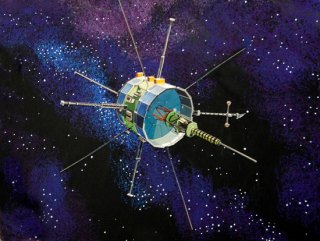NASA In Brief -- Citizen scientists to attempt control of spacecraft

Artist's concept of ISEE-3 (ICE). Image: NASA.
The space agency has agreed to allow Skycorp Inc., in Los Gatos, California, to contact "and possibly command and control," NASA’s International Sun-Earth Explorer-3 (ISEE-3). This is the first time NASA has made such an agreement regarding a spacecraft the agency is no longer using.
The ISEE-3 was launched in 1978 to study the constant flow of solar wind streaming toward Earth, according to NASA. After that mission was completed in 1981, the spacecraft still had fuel and functioning instruments. It was redirected to observe two comets and then continued in orbit around the sun. It is now making its closest approach to Earth in more than 30 years.
"The intrepid ISEE-3 spacecraft was sent away from its primary mission to study the physics of the solar wind extending its mission of discovery to study two comets," said John Grunsfeld, astronaut and associate administrator for the Science Mission Directorate at NASA headquarters in Washington. "We have a chance to engage a new generation of citizen scientists through this creative effort to recapture the ISEE-3 spacecraft as it zips by the Earth this summer."
The agreement between the company and NASA details the technical, safety, legal and proprietary issues that will be addressed before Skycorp attempts to communicate with or control the 1970s-era spacecraft as it nears the Earth in August.
The company's goal is to put the spacecraft into an orbit at a gravitationally stable point between Earth and the sun known as Lagrangian 1. Once the spacecraft is safely in orbit, the next step is to put it back into operation and use its instruments as they were originally designed.
ISEE-3's close approach in the coming weeks provides optimal conditions to attempt communication. If communications are unsuccessful, the spacecraft will swing by the moon and continue to orbit the sun.
NASA has shared technical data to help Skycorp communicate with and return data from ISEE-3. The contributions of any citizen science provided by the spacecraft, if it is successfully recovered, depend on the current condition of the instruments.
New data resulting from the project will be shared with the science community and the public, providing a unique tool for teaching students and the public about spacecraft operations and data gathering. The data also will provide valuable information about the effects of the space environment on the 36-year old spacecraft.
The ISEE-3 was launched in 1978 to study the constant flow of solar wind streaming toward Earth, according to NASA. After that mission was completed in 1981, the spacecraft still had fuel and functioning instruments. It was redirected to observe two comets and then continued in orbit around the sun. It is now making its closest approach to Earth in more than 30 years.
"The intrepid ISEE-3 spacecraft was sent away from its primary mission to study the physics of the solar wind extending its mission of discovery to study two comets," said John Grunsfeld, astronaut and associate administrator for the Science Mission Directorate at NASA headquarters in Washington. "We have a chance to engage a new generation of citizen scientists through this creative effort to recapture the ISEE-3 spacecraft as it zips by the Earth this summer."
The agreement between the company and NASA details the technical, safety, legal and proprietary issues that will be addressed before Skycorp attempts to communicate with or control the 1970s-era spacecraft as it nears the Earth in August.
The company's goal is to put the spacecraft into an orbit at a gravitationally stable point between Earth and the sun known as Lagrangian 1. Once the spacecraft is safely in orbit, the next step is to put it back into operation and use its instruments as they were originally designed.
ISEE-3's close approach in the coming weeks provides optimal conditions to attempt communication. If communications are unsuccessful, the spacecraft will swing by the moon and continue to orbit the sun.
NASA has shared technical data to help Skycorp communicate with and return data from ISEE-3. The contributions of any citizen science provided by the spacecraft, if it is successfully recovered, depend on the current condition of the instruments.
New data resulting from the project will be shared with the science community and the public, providing a unique tool for teaching students and the public about spacecraft operations and data gathering. The data also will provide valuable information about the effects of the space environment on the 36-year old spacecraft.
Related:
5 things to know: The space weather mission
NASA offers cash contest in hunt for asteroids

